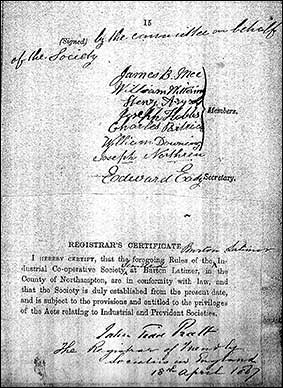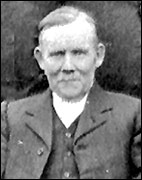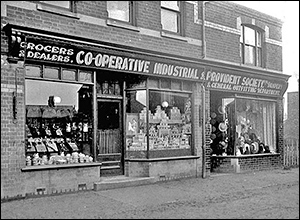| Article researched by John Langley 2006 |
||||||||||||||||
|
||||||||||||||||
|
||||||||||||||||
|
The Society was established in May 1888 and registered on
The First Store The shop, or store as it was referred to in the early years from 1867, I now believe to have been in the building which was quite large on the right hand corner of the High Street and Bakehouse Lane, which in later years was 1, High Street. All the likely buildings at that time have been considered and with research this seems to be the one. From working in the building in the 1950s, which became the co-op hardware shop in the late 1940s, I remember the internal layout. The front part of the shop with the door on the High Street was connected to the rear by an opening in the rear wall of more than half a metre thick, with one step up. There was also a pair of double doors in the rear half of the building, opening onto Bakehouse Lane which in the 1950s were fixed closed and not used. The stairs to the 1st floor were at the rear and there was a door that opened onto the garden also in the rear part. This indicates that this building was once in two separate parts, and it seems more likely that the front part was the first co-op store, as it would have had the shop door and windows on the High Street and no other access. The first recorded store manager was John Wittering in 1869. He may have been related to William Wittering one of the first members of the board in 1867, possibly his brother as they were of similar age. In the 1881 census John Wittering’s address is given as Bakehouse Lane, [earlier census’ have no addresses,] most likely in the rear of the building, and living on the 1st floor. In 1874 John Wittering appears in directories as a grocer and could have operated from the rear part of the building apart from the co-op. Joseph Mason was the co-op store manager in c1874, George Buckby in c1876, and Alfred Tailby in c1890. Whether this store continued with the co-op after the opening of the Duke Street shops in 1891 is speculative. A High Street shop is listed in co-op directories in 1905 and 1910, but not in 1893, [these are the only ones we have of this period] and the new High Street shops were not built until 1912/13. After registration at a committee meeting on Secretary: Ted Freestone, Treasurer:William Freeman. Committee Members: Lewis Mason, William Ball, Charles Stokes, Joseph Gale, William Reed, Joseph Eady and Jos Blaxley. At the meeting held on
The meetings were held over the next two years at three different locations, the Parochial School rooms, the On The location of the store before 1891 is presently unknown, but in 1890, land was purchased from a Mrs. C Jolly, each of the committee members investing £100 towards the project, and new stores were built in
To the left of the grocery was the opening to the yard at the rear, large enough for the horse drawn drays [carts] that delivered the milk and bread to pass. On the left of the opening was the bakehouse, the entrance to this was at the side within the opening with windows on the street, there was an opening on the first floor with a hoist so that lorries delivering sacks of flour could reverse into the opening and it would be lifted and stored there. On entering the yard the butchers shop was on the right. At the top of the yard facing the entrance was the abattoir. To the right were the animal pens and to the left were the stables for the horses with space to park the drays. The Co-op also owned a field in
|
||||||||||||||||


